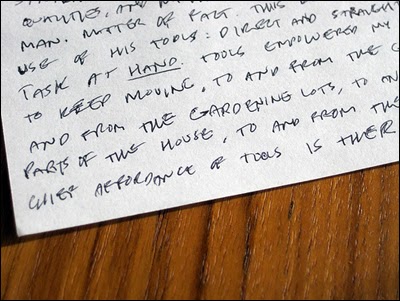
During the tour for his book “An Appetite for Wonder: The Making of a Scientist” (2013), evolutionary biologist Richard Dawkins was asked about his writing method at the California Institute of Technology in Pasadena. His answer:
“I never write with a pen. I always type on a computer. I, more or less, have forgotten to write with a pen. As with anybody, who gets [a copy of] their book, signed, will see.”Dawkins also added that before computers were prevalent, he typed his manuscripts.
It’s rare that I take pen to paper. When I do, it evokes feelings that are, minor in scale, physically, but large in scope, emotionally. There is comfort in holding a pen, touching paper, working on a physical desktop and feeling its supporting role as an extended writing surface. There is the curiosity afterwards of glancing at a sheet, filled with words, and noting the changes transcribed along the way.
Handwriting is an opportunity to advance revising while transcribing, but I often wind up feeling that it’s extra effort, considering that typing on a keyboard is already in a form to readily manipulate (in the software of choice on the hardware of choice).
Writing with a keyboard ultimately dominates my habits. The act of writing, using software as the tool, aligns with the creation of Web-based apps, like Draft and Editorially. Such software allows for the focused exercise of writing, while imbuing it with digital capabilities. This is a current advantage—and it’s tremendous.
There’s also the tremendous advantage of just using pen and paper. Dawkins’ response reminds me to try different ways of writing, with a pencil, pen, typewriter, or software. It’s amazing to have more than one reliable tool available when you want to write.
• • •
Photo is a part of my Project Details.
• • •
Read related post about my use of writing apps Draft and Editorially.
